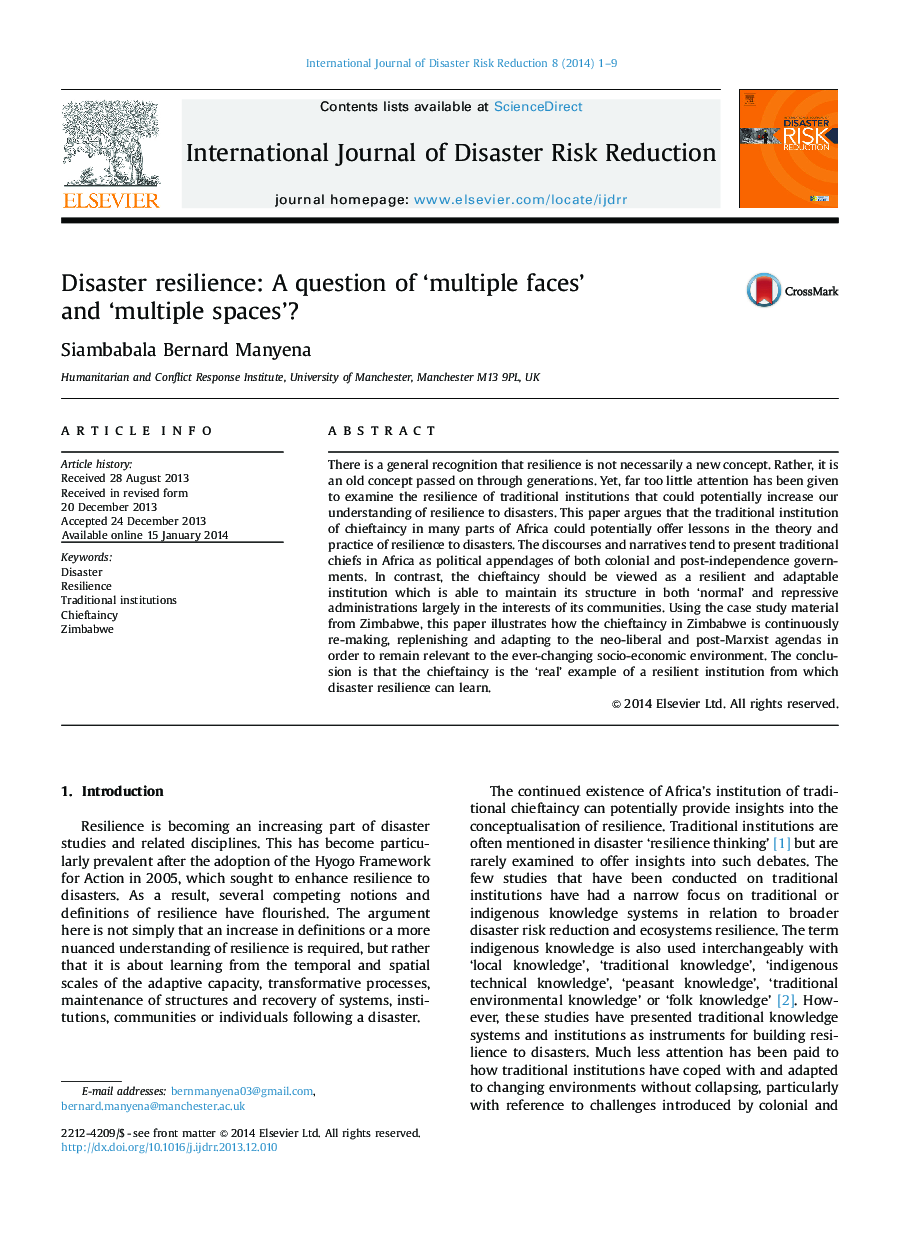| کد مقاله | کد نشریه | سال انتشار | مقاله انگلیسی | نسخه تمام متن |
|---|---|---|---|---|
| 7473612 | 1485166 | 2014 | 9 صفحه PDF | دانلود رایگان |
عنوان انگلیسی مقاله ISI
Disaster resilience: A question of 'multiple faces' and 'multiple spaces'?
ترجمه فارسی عنوان
انعطاف پذیری فاجعه: سوال "چهره های متعدد" و "فضاهای متعدد"؟
دانلود مقاله + سفارش ترجمه
دانلود مقاله ISI انگلیسی
رایگان برای ایرانیان
ترجمه چکیده
به رسمیت شناختن عمومی است که انعطاف پذیری لزوما یک مفهوم جدید نیست. در عوض، این یک مفهوم قدیمی است که از طریق نسل ها منتقل می شود. با این حال، توجه کم توجهی به انعطاف پذیری نهادهای سنتی که می تواند درک ما از انعطاف پذیری در برابر بلایا را افزایش دهد، مورد توجه قرار گرفته است. این مقاله استدلال می کند که نهاد سنتی فرمانروایی در بسیاری از نقاط آفریقا می تواند به طور بالقوه درس هایی را در نظریه و عمل انعطاف پذیری به فاجعه ارائه دهد. گفتمان ها و روایات به عنوان رهبران سنتی در آفریقا به عنوان ضمیمه های سیاسی از دولت های استعمار و پس از استقلال منجر شده است. در مقابل، فرمانروایی باید به عنوان یک نهاد انعطاف پذیر و قابل انعطاف در نظر گرفته شود که قادر است ساختار خود را در ادارات عادی و سرکوبگر به طور عمده به منافع جوامع آن حفظ کند. با استفاده از مواد مطالعه موردی از زیمبابوه، این مقاله نشان می دهد که چگونه رهبری در زیمبابوه به طور مداوم دوباره سازی، تکمیل و تطبیق با برنامه های نئولیبرال و پس مارکسیستی به منظور حفظ ارتباط با محیط زیست اجتماعی و اقتصادی همیشه در حال تغییر است. نتیجه گیری این است که فرماندهی، نمونه ای واقعی از یک نهاد انعطاف پذیر است که از انعطاف پذیری فاجعه می تواند یاد بگیرد.
موضوعات مرتبط
مهندسی و علوم پایه
علوم زمین و سیارات
فیزیک زمین (ژئو فیزیک)
چکیده انگلیسی
There is a general recognition that resilience is not necessarily a new concept. Rather, it is an old concept passed on through generations. Yet, far too little attention has been given to examine the resilience of traditional institutions that could potentially increase our understanding of resilience to disasters. This paper argues that the traditional institution of chieftaincy in many parts of Africa could potentially offer lessons in the theory and practice of resilience to disasters. The discourses and narratives tend to present traditional chiefs in Africa as political appendages of both colonial and post-independence governments. In contrast, the chieftaincy should be viewed as a resilient and adaptable institution which is able to maintain its structure in both 'normal' and repressive administrations largely in the interests of its communities. Using the case study material from Zimbabwe, this paper illustrates how the chieftaincy in Zimbabwe is continuously re-making, replenishing and adapting to the neo-liberal and post-Marxist agendas in order to remain relevant to the ever-changing socio-economic environment. The conclusion is that the chieftaincy is the 'real' example of a resilient institution from which disaster resilience can learn.
ناشر
Database: Elsevier - ScienceDirect (ساینس دایرکت)
Journal: International Journal of Disaster Risk Reduction - Volume 8, June 2014, Pages 1-9
Journal: International Journal of Disaster Risk Reduction - Volume 8, June 2014, Pages 1-9
نویسندگان
Siambabala Bernard Manyena,
